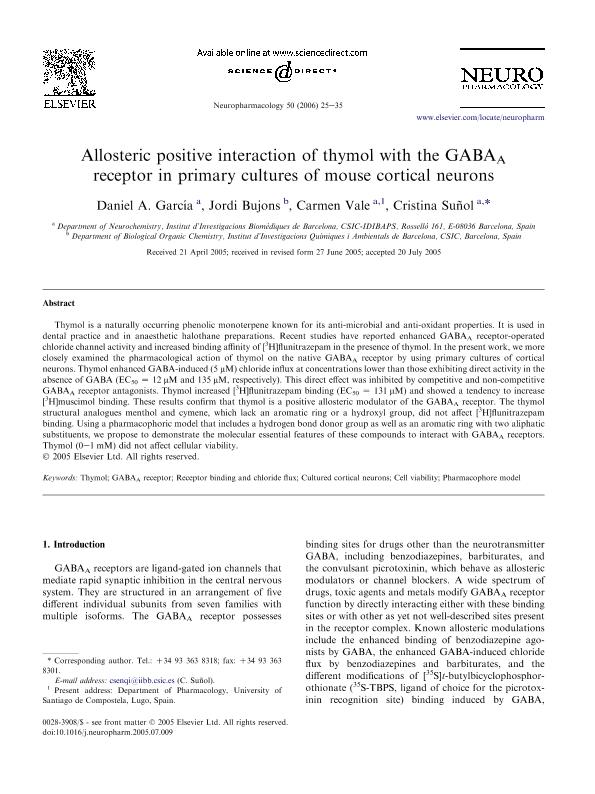Mostrar el registro sencillo del ítem
dc.contributor.author
Garcia, Daniel Asmed

dc.contributor.author
Bujons, Jordi
dc.contributor.author
Vale, Carmen
dc.contributor.author
Suñol, Cristina
dc.date.available
2018-08-29T20:21:40Z
dc.date.issued
2006-01
dc.identifier.citation
Garcia, Daniel Asmed; Bujons, Jordi; Vale, Carmen; Suñol, Cristina; Allosteric positive interaction of thymol with the GABA-A receptor in primary cultures of mouse cortical neurons; Pergamon-Elsevier Science Ltd; Neuropharmacology; 50; 1; 1-2006; 25-35
dc.identifier.issn
0028-3908
dc.identifier.uri
http://hdl.handle.net/11336/57589
dc.description.abstract
Thymol is a naturally occurring phenolic monoterpene known for its anti-microbial and anti-oxidant properties. It is used in dental practice and in anaesthetic halothane preparations. Recent studies have reported enhanced GABAA receptor-operated chloride channel activity and increased binding affinity of [3H]flunitrazepam in the presence of thymol. In the present work, we more closely examined the pharmacological action of thymol on the native GABAA receptor by using primary cultures of cortical neurons. Thymol enhanced GABA-induced (5 μM) chloride influx at concentrations lower than those exhibiting direct activity in the absence of GABA (EC50 = 12 μM and 135 μM, respectively). This direct effect was inhibited by competitive and non-competitive GABAA receptor antagonists. Thymol increased [3H]flunitrazepam binding (EC50 = 131 μM) and showed a tendency to increase [ 3H]muscimol binding. These results confirm that thymol is a positive allosteric modulator of the GABAA receptor. The thymol structural analogues menthol and cymene, which lack an aromatic ring or a hydroxyl group, did not affect [3H]flunitrazepam binding. Using a pharmacophoric model that includes a hydrogen bond donor group as well as an aromatic ring with two aliphatic substituents, we propose to demonstrate the molecular essential features of these compounds to interact with GABAA receptors. Thymol (0-1 mM) did not affect cellular viability.
dc.format
application/pdf
dc.language.iso
eng
dc.publisher
Pergamon-Elsevier Science Ltd

dc.rights
info:eu-repo/semantics/openAccess
dc.rights.uri
https://creativecommons.org/licenses/by-nc-sa/2.5/ar/
dc.subject
Cell Viability
dc.subject
Cultured Cortical Neurons
dc.subject
Gabaa Receptor
dc.subject
Pharmacophore Model
dc.subject
Receptor Binding And Chloride Flux
dc.subject
Thymol
dc.subject.classification
Otras Ciencias Biológicas

dc.subject.classification
Ciencias Biológicas

dc.subject.classification
CIENCIAS NATURALES Y EXACTAS

dc.title
Allosteric positive interaction of thymol with the GABA-A receptor in primary cultures of mouse cortical neurons
dc.type
info:eu-repo/semantics/article
dc.type
info:ar-repo/semantics/artículo
dc.type
info:eu-repo/semantics/publishedVersion
dc.date.updated
2018-08-13T17:05:38Z
dc.journal.volume
50
dc.journal.number
1
dc.journal.pagination
25-35
dc.journal.pais
Estados Unidos

dc.journal.ciudad
Nueva York
dc.description.fil
Fil: Garcia, Daniel Asmed. Consejo Nacional de Investigaciones Científicas y Técnicas. Centro Científico Tecnológico Conicet - Córdoba. Instituto de Investigaciones Biológicas y Tecnológicas. Universidad Nacional de Córdoba. Facultad de Ciencias Exactas, Físicas y Naturales. Instituto de Investigaciones Biológicas y Tecnológicas; Argentina. Consejo Superior de Investigaciones Científicas; España. Institut d'Investigacions Biomèdiques de Barcelona; España
dc.description.fil
Fil: Bujons, Jordi. Consejo Superior de Investigaciones Científica; España. Institut d'Investigacions Químiques i Ambientals de Barcelona; España
dc.description.fil
Fil: Vale, Carmen. Consejo Superior de Investigaciones Científicas; España. Institut d'Investigacions Biomèdiques de Barcelona; España. Universidad de Santiago de Compostela; España
dc.description.fil
Fil: Suñol, Cristina. Consejo Superior de Investigaciones Científicas; España. Institut d'Investigacions Biomèdiques de Barcelona; España
dc.journal.title
Neuropharmacology

dc.relation.alternativeid
info:eu-repo/semantics/altIdentifier/url/https://www.sciencedirect.com/science/article/pii/S0028390805002716
dc.relation.alternativeid
info:eu-repo/semantics/altIdentifier/doi/http://dx.doi.org/10.1016/j.neuropharm.2005.07.009
Archivos asociados
